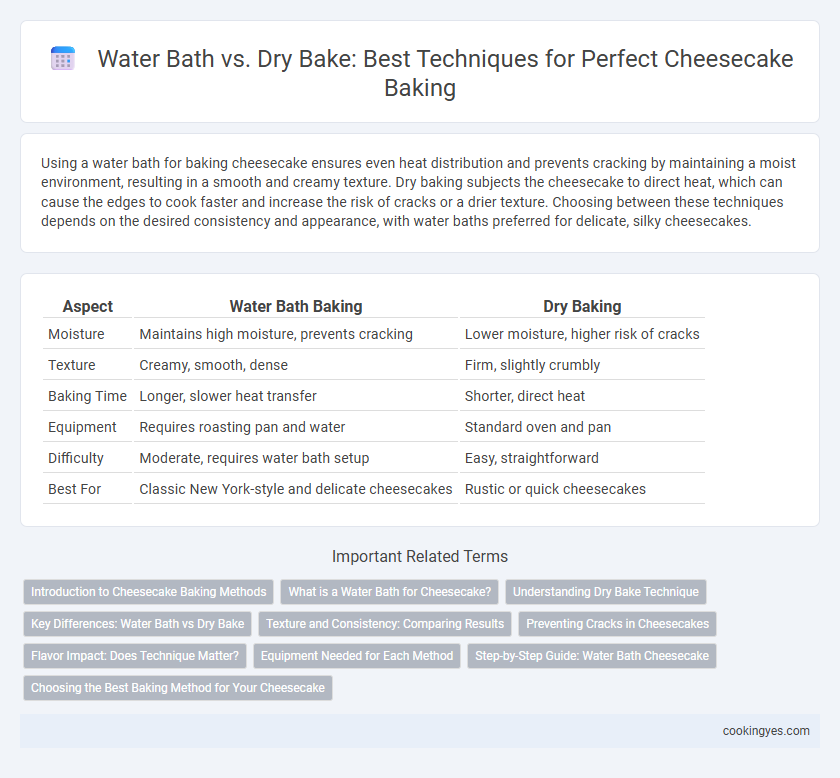Using a water bath for baking cheesecake ensures even heat distribution and prevents cracking by maintaining a moist environment, resulting in a smooth and creamy texture. Dry baking subjects the cheesecake to direct heat, which can cause the edges to cook faster and increase the risk of cracks or a drier texture. Choosing between these techniques depends on the desired consistency and appearance, with water baths preferred for delicate, silky cheesecakes.
Table of Comparison
| Aspect | Water Bath Baking | Dry Baking |
|---|---|---|
| Moisture | Maintains high moisture, prevents cracking | Lower moisture, higher risk of cracks |
| Texture | Creamy, smooth, dense | Firm, slightly crumbly |
| Baking Time | Longer, slower heat transfer | Shorter, direct heat |
| Equipment | Requires roasting pan and water | Standard oven and pan |
| Difficulty | Moderate, requires water bath setup | Easy, straightforward |
| Best For | Classic New York-style and delicate cheesecakes | Rustic or quick cheesecakes |
Introduction to Cheesecake Baking Methods
Water bath baking ensures even heat distribution and prevents cracks by maintaining moisture around the cheesecake, ideal for delicate textures like New York-style. Dry baking offers a firmer, denser crust and quicker cooking times but can risk dryness or cracking without proper temperature control. Choosing between these methods depends on the desired consistency and finish of the cheesecake.
What is a Water Bath for Cheesecake?
A water bath for cheesecake involves placing the cheesecake pan inside a larger pan filled with hot water, which ensures even heat distribution and prevents the cake from cracking. This gentle baking method maintains moisture and creates a smooth, creamy texture by regulating temperature fluctuations during baking. Unlike dry baking, a water bath minimizes the risk of overbaking, resulting in a perfectly tender and luscious cheesecake.
Understanding Dry Bake Technique
Dry bake technique for cheesecake involves baking the batter in a conventional oven without a water bath, resulting in a denser and firmer texture compared to the creamy and smooth outcome of a water bath method. This approach requires precise temperature control, typically around 325degF (163degC), and careful monitoring to prevent cracking or overbaking. Many bakers prefer dry baking for its simplicity and the ability to achieve a slightly caramelized, golden top that enhances flavor and presentation.
Key Differences: Water Bath vs Dry Bake
Water bath baking creates a moist, steam-filled environment that ensures even heat distribution and prevents the cheesecake from cracking, resulting in a smooth, creamy texture. Dry bake method exposes the cheesecake directly to dry heat, often leading to a firmer, denser texture with a slightly browned top. Choosing between water bath and dry bake depends on desired cheesecake consistency and presentation.
Texture and Consistency: Comparing Results
Water bath baking produces a creamy, smooth texture in cheesecake by providing even heat and preventing cracks, resulting in a delicate, custard-like consistency. Dry baking often leads to a denser, firmer texture with a slightly crumbly surface due to direct oven heat and faster cooking. Choosing between these methods impacts the final cheesecake's mouthfeel, with water baths favored for silky softness and dry baking for a more structured slice.
Preventing Cracks in Cheesecakes
Water bath baking maintains even, moist heat around the cheesecake, minimizing temperature fluctuations that cause cracks. Dry baking exposes the cheesecake to direct oven heat, increasing the risk of overcooking edges and forming surface cracks as it cools. Using a water bath with sealed pans ensures gentle baking, preserving a smooth, crack-free texture in cheesecakes.
Flavor Impact: Does Technique Matter?
Water bath baking enhances cheesecake's creamy texture and prevents cracks by maintaining even heat and moisture, resulting in a smooth, rich flavor. Dry baking can create a denser, slightly drier texture with more pronounced caramelization, intensifying the crust and edges' flavor. Choosing the technique depends on desired texture and flavor balance, but water bath baking generally preserves a delicate, consistent taste.
Equipment Needed for Each Method
Water bath cheesecake baking requires a large roasting pan and aluminum foil to tightly seal the springform pan, ensuring a moist environment that prevents cracking. Dry baking necessitates a sturdy springform pan and often a baking sheet to catch any drips, relying on controlled oven heat without added moisture. Proper equipment choice significantly influences texture and appearance in cheesecake preparation.
Step-by-Step Guide: Water Bath Cheesecake
Using a water bath for cheesecake baking ensures even heat distribution, preventing cracks and creating a smooth, creamy texture. Start by wrapping the springform pan with aluminum foil to prevent water seepage, then place it in a larger pan filled halfway with hot water. Bake at a low temperature until the cheesecake is set but still slightly jiggly in the center, then cool gradually to maintain its rich consistency.
Choosing the Best Baking Method for Your Cheesecake
Choosing the best baking method significantly affects cheesecake texture and moisture. Water bath baking creates a smooth, creamy consistency by providing gentle, even heat and preventing cracks through added humidity. Dry baking produces a firmer, denser cheesecake with a more pronounced crust, ideal for recipes requiring a structured finish.
Water bath vs Dry bake for cheesecake baking technique Infographic

 cookingyes.com
cookingyes.com